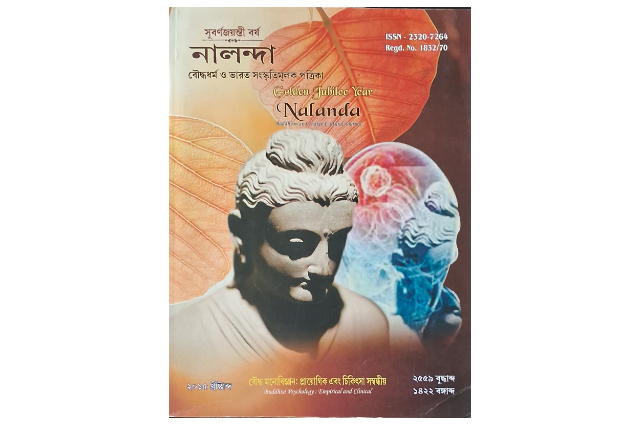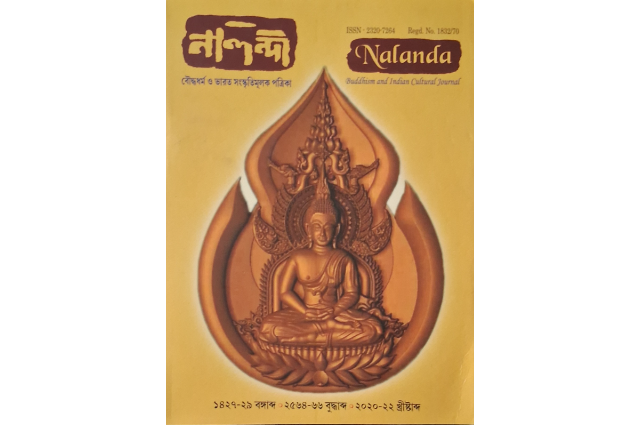
Nalanda is an annual journal dedicated to Buddhism, Buddhist cultural studies research, and allied areas. It is published in three different languages English, Bengali, and Hindi; and provides coverage of Buddhism and cultural issues across the globe with special emphasis on South and South East Asia. The contributors are spread across South and South East Asia including Nepal, Bhutan, India, Tibet, China, Hong Kong, Bangladesh, Sri Lanka, Myanmar, Thailand, Vietnam, Cambodia, Laos, and Singapore. There are also regular contributors from Japan, Mongolia, South Korea, the USA, the UK, France, Germany, and Canada making this volume truly international. The topics covered include various aspects of Buddhist history, archeology, anthropology, linguistics, Buddhist socio-cultural and religious practices, discourse, and critical academic discussions on both Hinayana and Mahayana Buddhist scriptures, texts, and manuals.
Hence, each volume of the Nalanda journal is indeed a treasure house of Buddhist and related cultural studies from multiple perspectives. Contributed by leading scholars and academics, researchers, and leading national and international intellectuals on various socio-cultural aspects of Buddhism is the lifeline of this journal and its strength in connecting communities of both scholars and general readers. The editorial board unused the leadership of venerable Dr. Sumanapal Bhikkhu and his editorial board representing an internationally group of dedicated group of scholars, researchers, academics, reviewers, columnists, and scientists must be credited for successfully maintaining the unique diversity of thoughts and ideas as well as the quality of articles published in each issue. Published from the famous Nidhi Bodhi Publication group from Kolkata, West Bengal India specializing in Buddhist studies and research. The voluminous Nalanda annual journal can be easily designated as one of the top 5% peer-reviewed research publications related to Buddhism as well as Buddhist social, religious, and allied cultural studies in both India and abroad. In spite of these rich credentials and attributes unfortunately we do not find its name in the UGC wish list of journals in Buddhism, Buddhist studies, and related areas!
The coverage of this issue has been phenomenal as it connects both old traditional Buddhist studies with modern applications in recent times as well as their timely interpretations and representation in modern human society around the planet. Not just English, Bengali, and Hindi; various papers in the Nalanda journal also highlight scriptures, texts, and teachings in other Asian languages like Sanskrit, Pali, Nepali, Dzongkha, Burmese, Thai, Tibetan, Mongolian, Vietnamese, Japanese and Chinese languages making the volume truly international in perspective. Furthermore, the inclusion of interpretive images of unique statues, archeological sites and structures, pages of ancient scriptures, rare palm leaf texts and old unavailable books, Buddhist images, designs, motifs, and maps add further dimensions to the erudite articles and the national as well as international publications.

Being an annual publication with only one issue per year, the journal is voluminous teaching 550-600 pages, but the effort is worth it due to the rich quality of material content published once a year on Buddhism and related themes. The subscriber list has been increasing fast but the cost of running the publication is also quite high. Donations by patrons and other members have saved the journal from going out of publication during the time of the pandemic. The role of the editor, editorial board, publishing staff, volunteers, well-wishers, and devotes are duly acknowledged for their monumental supportive responsibilities each of which was achieved tenaciously. The publication will be useful for academics, and research scholars, who are students of Buddhist religion and sociology-cultural studies. This will also be useful to academics, researchers, scholars, and teachers of Religious Studies, History, Archaeology, Sociology, Women's Studies, Political Science, Philosophy, thanks Literature, Eastern Studies, Museology, and allied disciplines.
